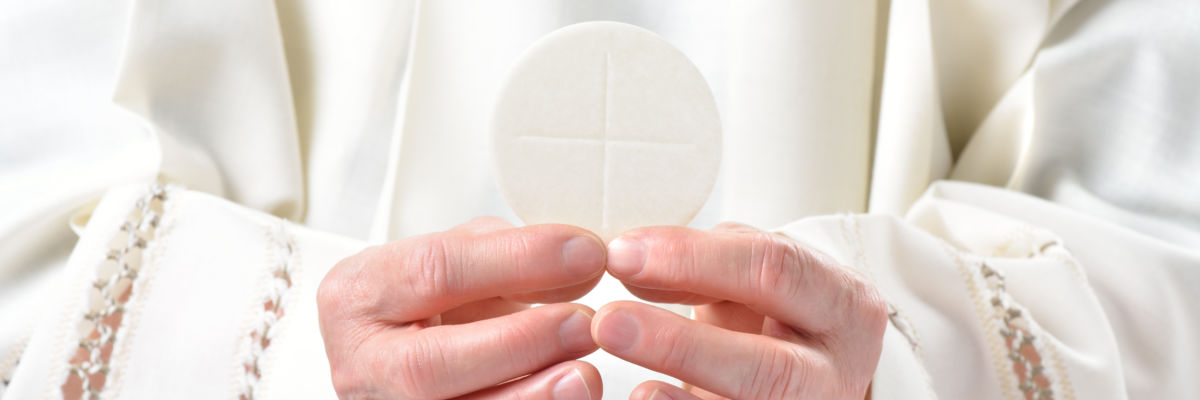
Unraveling the mystery of the Eucharist. Deacon Harold Burke-Sivers delves into the language of the Last Supper to demonstrate the meaning of Jesus’ words, “This is my body.” Learn how the Old Testament concept of the “bread of the presence” foreshadows the Eucharist. He touches on the linguistic evidence supporting the Real Presence of Christ in the Catholic Eucharist.
Transcript:
Hi, how would I convince a Protestant that the Eucharist for the 1500 year history from when the Catholic Church was started up till the Protestant Reformation, that the Eucharist wasn’t just a symbol in the Church and that it was truly seen by everyone as the true presence of Jesus? Yeah, great question. So first of all, you have to recognize you can’t convince anybody of anything.
The belief in the Eucharist also comes down to faith. You can make the greatest arguments in the world, but all you’re doing is throwing seeds.
It’s God that has to till the soil and give a fertilizer and sunlight and allow the seed of faith to grow in that person’s heart. You can’t do that, only God can do that. That’s the first thing to recognize. The second one is this. Look at the words of Jesus in Matthew, Mark, and Luke’s gospel, the synoptic gospel. Not in John because John doesn’t have the last sub-narrative, but in the three. For example, Luke 22, 19, it says, “This is my body.” Literally, “touto estin to sōma mou.” This is the body of me. Now how do we know, what does that mean when the person is speaking that? If you ask any Greek scholar, they will tell you that the writer is using the monster of adjective, in this case Luke, the monster of adjective “this.”
What do adjectives modify nouns? Whatever “this” is, is making absolute identification with the object of the sentence with the “soma,” which is body. Now, if that was bread that he was holding, you would see the Greek word “artos,” which means bread. But instead, you see “soma,” which means body. So literally, he’s saying, “This is the body.” Whatever “this” is, whatever he’s holding in his hand, he’s equating that unequivocally with his physical body.
The only way you can get a different explanation is something called “isa Jesus.” “Xa Jesus” is when you read a text and you extract the meaning from the text. “Iza Jesus” is when you read your own meaning into the text. So now the text doesn’t mean what it actually says, it means what you want it to mean. And that’s not honest. You have to look at what the text says for itself. So in fact, I had an atheist Greek scholar explain this exact thing to me. The person who’s speaking, saying, “This is my body,” he’s saying he’s making absolute identification between himself and the physical thing that he’s holding in his hand.
And the only way you can get a different meaning is to make it mean something else. That’s just a reason. And that goes perfectly when we were talking about John 6 earlier, when Jesus, “Eat my flesh and drink my blood,” they heard him literally because he was speaking literally, not figuratively. Does that help?
Yeah, that makes sense. Thank you. All right. Dominic, thank you. Thanks very much. That’s very…
Yeah, there’s something really persuasive about that. Like you said, you can’t make someone else believe it, but this is my body.
Where’s the wiggle room in that?
Well, the thing is, there’s precedence back in the Old Testament about consuming the bread and the presence of God being in the bread.
Back then it was figuratively in the Old Testament. It talks about the L’chaim ha-panim, the bread of the presence or the bread of the face. Well, whose presence, whose face? God’s. God’s presence, God’s face. In fact, the book of Leviticus says that whenever the L’chaim ha-panim was in the tabernacle, there had to be a light that was continually lit. Whenever the bread of the presence, the bread of the face was in the tabernacle. And to this day, we have a sanctuary light that’s lit whenever the Eucharist is in the tabernacle. See, so we have some parallels between the Old Testament and the New Testament, which makes perfect sense. Jesus said, “I have not come to abolish the law and the prophets to fulfill them.” So Jesus in the Eucharist is the fulfillment of this idea of the L’chaim ha-panim in the Old Testament.
Hey, thanks for watching. If you like this Catholic answer, be sure to like, subscribe, and check out our live streams Monday through Friday, 3 to 5 p.m. Pacific, or find the episode after on YouTube, your favorite podcast platform, or our Catholic Answers app.



